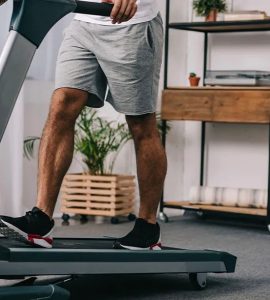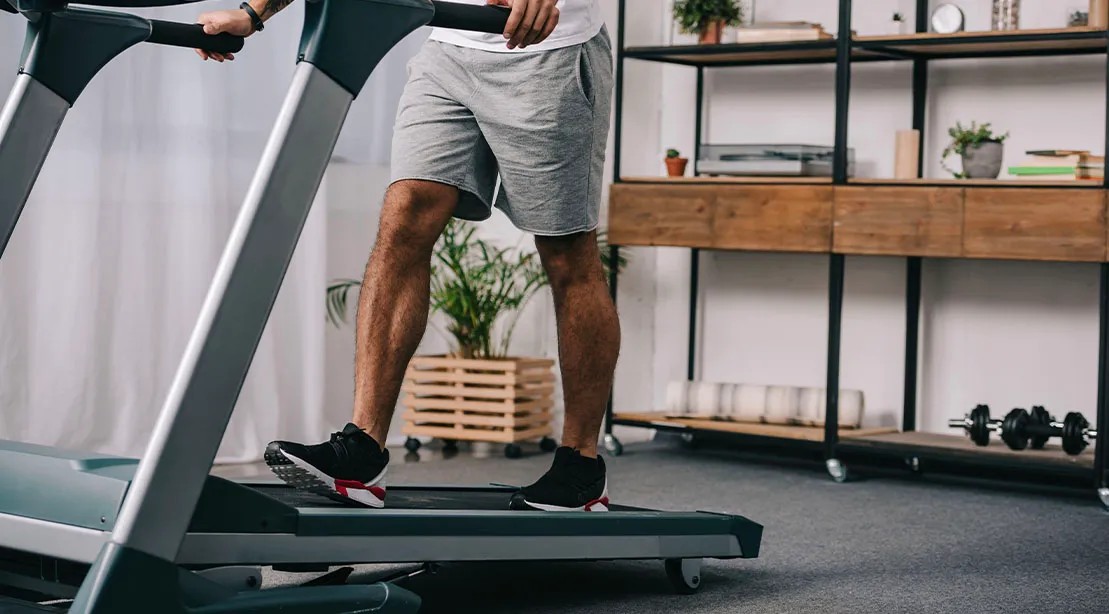 Posted On
Posted On
15 Benefits of Treadmill Workouts
 Posted On
Posted On
Treadmills stand out as the most popular home exercise equipment in the UK, with homes having 300,000 – 400,000 units. This popularity comes with good reason too. The benefits of running on a treadmill go way beyond just burning calories – it’s great for your body and mind.
Research shows that people who walk regularly face lower risks of cardiovascular disease, type 2 diabetes, and dementia. Your heart health improves significantly through treadmill workouts that lower blood pressure and cholesterol levels. A simple 30-minute walk burns between 150-200 calories. The exercise releases endorphins – those natural mood boosters that make you feel great. The growing treadmill trend highlights how convenient and effective this form of exercise has become for people of all ages. Your body’s blood flow increases when you walk on a treadmill, sending oxygen-rich nutrients to your cells and muscles, which helps improve circulation and joint flexibility.
Treadmill workouts are a great way to get fit, whatever your goals might be. You might want to shed some pounds, boost your heart health, feel less stressed, or just exercise without worrying about the weather. Let’s look at 15 key benefits that make treadmill training such a powerful addition to your fitness journey.
Improves Cardiovascular Health and Circulation
Treadmill exercise makes your cardiovascular system stronger through several key body mechanisms. Your body changes immediately during each workout and these changes add up to lasting health benefits.
Heart rate elevation and oxygen delivery
Your body coordinates several cardiovascular responses as you step on a treadmill. Your heart rate goes up because vagal tone decreases and sympathetic tone increases, which helps deliver more oxygen throughout your body. Your working muscles need this response to meet their increased oxygen demands.
You can target specific heart rate zones to measure your workout intensity effectively. The simple formula to calculate your maximum heart rate is 220 minus your age in years. Your ideal fat-burning zone should be between 50-70% of this maximum. A 30-year-old person’s maximum heart rate would be 190 beats per minute, with fat-burning happening between 95-133 beats per minute.
Your heart learns to pump blood more efficiently through regular treadmill workouts. This makes your heart muscle stronger over time, so it pumps blood better with each beat. Better blood circulation helps oxygen and nutrients reach your muscles and organs faster, which boosts your overall health and vitality.
Lowering blood pressure through regular use
Treadmill exercise helps lower blood pressure, which stands out as one of its biggest cardiovascular benefits. Your heart becomes stronger and pumps more blood with less effort, which puts less force on blood vessels and lowers blood pressure. Research shows drops of 4-10 mm Hg in systolic pressure and 5-8 mm Hg in diastolic pressure with regular exercise.
You’ll start seeing real improvements in blood pressure after 1-3 months of consistent exercise. The recommended amount is at least 150 minutes of moderate aerobic activity or 75 minutes of vigorous aerobic activity weekly.
Research suggests an interesting approach – splitting your treadmill workouts into shorter sessions throughout the day might work better for managing blood pressure. One study showed that three 10-minute walks each day prevented blood pressure spikes better than a single 30-minute walk. This makes treadmill workouts easier to fit into busy schedules.
Supports Effective Weight Loss Goals
Treadmill workouts are a great way to lose weight. They help create calorie deficits and protect your muscle mass at the same time.
Calorie burn at different speeds and inclines
Your treadmill workout effectiveness depends on how many calories you burn. Harvard Medical School reports that a 155-pound person burns about 150 calories when walking for 30 minutes at 3.5 mph. Running at 6 mph burns even more – around 372 calories in the same time period.
Adding an incline makes a huge difference in calories burned. Research shows you’ll burn 52% more calories at a 5% incline and 113% more at a 10% incline compared to walking on flat ground. Walking at inclines between 5-12% helps you maximize calorie burn without putting stress on your joints like running does.
Here’s what works best based on your fitness level:
- Beginners: 20-30 minutes at 5-8% incline
- Intermediate: 30-40 minutes at 10-12% incline
- Advanced: 40-45 minutes at 12-15% incline
Fat loss vs muscle retention on treadmill
Treadmill workouts can help you lose fat while keeping your muscle mass. A newer study compared incline walking to running and found something interesting. Both activities burned similar calories, but incline walking burned 40% of its calories from fat while running only burned 33%.
This happens because zone 2 training (65-75% of maximum heart rate) uses fat as its main fuel source instead of carbohydrates. When you increase intensity during running, your body switches from burning fat to burning carbs.
High-Intensity Interval Training (HIIT) on treadmills works even better – you’ll burn 30% more calories than regular cardio. HIIT keeps burning calories for hours after your workout through the EPOC effect.
To lose weight steadily, try to burn 500-1,000 more calories than you eat each day. This should help you lose 1-2 pounds weekly. Regular treadmill workouts and proper nutrition together create the perfect recipe for long-term weight management.
Boosts Mental Health and Reduces Stress
Treadmill exercise provides remarkable mental health benefits through specific neurochemical and psychological mechanisms, not just physical improvements.
Endorphin release during treadmill workouts
Your brain undergoes biochemical changes that boost your mood during treadmill exercise. These workouts trigger endorphins—natural mood-elevating chemicals that make you feel satisfied and relaxed for up to two hours after exercise. Research shows the classic “runner’s high” isn’t just about endorphins.
Scientists have found that endocannabinoids—substances your body naturally produces—are vital to post-exercise mood elevation. Endocannabinoids easily move from bloodstream to brain, unlike endorphins which can’t cross the blood-brain barrier. These compounds promote reduced anxiety and feelings of calm. Exercise increases their levels, creating a natural anti-stress response.
Your body’s primary stress hormone, cortisol, decreases during treadmill workouts. This change guides you toward a calmer, more relaxed mental state afterward.
Treadmill walking for anxiety and depression
Treadmill exercise works well against anxiety and depression. Physical activity prevents anxiety-like behaviors by affecting neural circuits. A clinical trial with women who have Type 2 diabetes showed better anxiety, depression, and social well-being scores after a 12-week treadmill walking program.
Rhythmic treadmill walking acts like moving meditation and helps shift your focus away from anxious thoughts. Exercise can work as well as antidepressants for some people with mild to moderate depression. One study showed that 30 minutes of treadmill walking for 10 straight days significantly reduced depression scores.
Interval training on treadmills works exceptionally well because alternating intensity levels keeps your mind active while maximizing mood benefits. You can start with short 10-15 minute sessions and gradually increase duration as your stamina improves.
Strengthens Lower Body Muscles
Treadmill workouts build and strengthen the core lower body muscle groups through steady movement and increasing resistance.
Glutes, hamstrings, and calves engagement
Each step on your treadmill works multiple muscle groups at once. Your glutes, hamstrings, and calves team up to push your body forward and power each stride. This steady motion challenges these muscles and builds their strength and endurance over time.
Your quadriceps, hamstrings, calves, and glutes get a great workout when you walk or run on a treadmill. Strong muscles lead to better form, improved efficiency, and faster leg movement. This extra muscle work burns more energy during and after your workout.
Different treadmill exercises shape your muscles in unique ways. Long, easy sessions target Type I muscle fibers, while sprints work on Type II fibers. The big movement muscles like glutes and quads have more Type II fibers, which help with power and speed.
Incline walking for muscle activation
The treadmill incline turns a basic walk into a strength-building session by working more muscles. Your glutes, quadriceps, and calves work much harder when you set the incline between 5-10%.
Incline training works wonders for your posterior chain—hamstrings, glutes, and lower back muscles. Your body leans forward as the angle gets steeper, which makes these muscles work harder. Your calves push off with more force in each step, which builds strength and makes your ankles more flexible.
Research shows that walking uphill makes the soleus and vastus lateralis muscles work harder. A 5-7% incline creates the perfect setup for balanced glute activation. Training at higher inclines helps you build strong legs.
Enhances Joint Stability and Bone Strength
Treadmills provide better structural benefits than outdoor surfaces when it comes to joint health and bone density. You can control your exercise conditions much better indoors.
Low-impact surface for joint protection
Most treadmills come with a cushioned surface that works like a shock absorber and reduces the force on your joints. This feature makes treadmill workouts valuable when you’re recovering from a lower-body injury or have sensitive joints. The belt and deck have special cushioning systems under the walking surface that protect your joints, bones, and muscles better than hard pavement.
Your knees will thank you as treadmills act as “personal knee guardians” by letting you work out with all cardiovascular benefits but less pain. You can maintain calorie burn without stressing your knee joints by focusing on low-speed walks that minimize bounce. The smooth joint movements and reduced load on knee extensors make treadmill exercise ideal if you have knee degeneration or soft tissue injuries.
Bone loading benefits from weight-bearing exercise
Treadmill workouts count as weight-bearing exercises where your bones support your body weight against gravity. These exercises are vital in building and maintaining bone density.
Research shows that medium-intensity treadmill running helps increase bone mineral density (BMD) by stimulating bone formation. The benefits depend on how long and hard you exercise – 9 weeks works better than 5 weeks, and medium intensity gives better results than low intensity. Regular treadmill training increases your bones’ cross-sectional area, which directly improves bone strength.
Treadmill walking is a great low-impact weight-bearing option if you have conditions like osteoporosis. It helps maintain your skeletal strength. The combination of mechanical loading and biochemical changes makes treadmill exercise effective at supporting bone health as you age.
Improves Stamina and Endurance Over Time
Your stamina builds up naturally when you follow a well-laid-out treadmill training plan. Your body adapts and grows stronger with each workout session that challenges you.
Progressive overload using speed and incline
Progressive overload creates the foundation of good endurance training on treadmills. Your cardiovascular system adapts continuously when you gradually increase workout intensity over time. You might start at a steady pace and then bump up your speed by 0.3-0.5 mph in each new workout.
Your best results come from mixing different training intensities. Research shows that high-intensity interval training boosts VO2 max more than steady-state cardio. The improvement ranges from 5.5-7.2% compared to minimal gains from lower intensity work. Here’s what works best:
- Start with 6 intervals at 90-95% maximum heart rate
- Work up to 12 intervals as you get fitter
- Cut down recovery time between efforts from 3.5 minutes to 2 minutes
Tracking VO2 max improvements
VO2 max shows how much oxygen your body can use during exercise. This key measure tells you about your cardiovascular fitness. Your workouts become more intense as this number goes up.
Regular treadmill training can lead to amazing results. Some people boost their VO2 max by 96% over 24 months of progressive training. These gains happen because your heart gets better at pumping blood with each beat, sending more oxygen to your muscles.
You’ll notice real changes in your performance. Your workouts last longer, you run faster, and you recover quicker between sessions.
Allows Safe Workouts Regardless of Weather
Bad weather can make it tough to stick to your fitness routine. Treadmills give you a practical way to tackle this challenge.
Indoor consistency during rain or snow
Treadmills become your best friends in harsh weather conditions. Running speedwork on icy or snow-packed roads is nowhere near possible. The indoor option helps you stay on track with your training schedule. A running coach puts it perfectly: “When winter weather hits and you’ve got speedwork on the menu, sometimes heading indoors is your only option”.
You can count on treadmills to help you work out whatever the weather throws at you – thunderstorms, heavy snow, or scorching heat. These machines are a great way to get steady progress without weather getting in your way.
Avoiding heatstroke or cold-related injuries
Treadmills do more than just offer convenience – they keep you safe from temperature-related health risks. Running indoors protects you from dangerous conditions that could cause heatstroke or increase your chance of injury in freezing temperatures.
Structured speedwork on treadmills beats the boredom that comes with indoor running. Different inclines and speeds create engaging workouts that work well without exposing you to outdoor risks.
Treadmill training lets you focus on getting the most from your workout instead of dealing with tricky terrain. The controlled setting means you won’t have to dodge potholes, branches, or patches of ice.
Customizes Workouts for All Fitness Levels
Treadmills are versatile machines that adapt to your fitness level with adjustable settings. A single machine opens up countless workout possibilities.
Beginner-friendly walking programs
New exercisers can build their fitness base with steady-state walks. Your workout should start with a 5-minute warm-up at 2.5-3 mph. The main session runs at 3.5-4 mph for 20-30 minutes. A 5-minute slower walk helps you cool down. Once you feel comfortable, you can try walking intervals. Switch between 5 minutes of brisk walking and 2 minutes at a slower pace.
Your joints will thank you when you opt for incline walking. A simple 1% incline matches outdoor conditions and protects your knees. Many people love the 12-3-30 workout. This 30-minute session at 3 mph with 12% incline targets your calves, glutes, and hamstrings without any running.
Advanced HIIT and tempo runs
Athletes with more experience can push their limits through high-intensity interval training. A powerful workout combines 20-second sprints at 10-12 mph with 40-second recovery jogs at 4-5 mph for 20-30 minutes. Pyramid intervals offer another challenge. These start with 30-second sprints at 6.5 mph followed by 1-minute walks. The sprint duration increases gradually.
Tempo runs help you build endurance at a challenging but manageable pace. Run at 85-90% of your maximum effort for 20-30 straight minutes. This workout improves your aerobic capacity and teaches you better pace control.
Enables Real-Time Progress Tracking
Modern treadmills change your workout experience with smart tracking features that give you instant feedback about your performance.
Using treadmill dashboards and wearables
Today’s treadmills come with digital displays that show multiple metrics at once. You can see your distance, speed, time, and calories burned as you exercise. This instant feedback helps you adjust your workout to get better results. The advanced models feature interactive touchscreens that show these metrics and let you pick workout settings and training programs.
Your workout tracking becomes even more detailed when you connect wearable devices to your treadmill. Smartwatches, fitness trackers, and heart rate monitors sync through Bluetooth to add more data. The information flows both ways – to cite an instance, Apple’s GymKit technology sends treadmill elevation data to your watch while your heart rate shows up on the treadmill screen.
Monitoring heart rate, pace, and distance
Heart rate tracking during treadmill workouts helps you stay at the right intensity level. Moderate exercise happens at 50-70% of your maximum heart rate, while vigorous exercise ranges from 70-85%. This continuous monitoring helps you get the most cardiovascular benefits without pushing too hard.
Wearables use accelerometers to track distance when GPS signals aren’t available inside. Your device readings might differ by 10-25% from actual performance numbers, based on how you run and your equipment quality. Many users make their tracking more accurate by comparing their outdoor GPS runs with indoor treadmill sessions.
Supports Better Sleep and Recovery
Treadmill exercise helps you sleep better through specific body mechanisms that boost rest and recovery.
Evening treadmill walks for sleep onset
A moderate workout on your treadmill boosts melatonin production – the hormone that helps you sleep soundly. When you walk or jog lightly for thirty minutes, your body uses up energy reserves which naturally enhances your recovery during sleep. Studies show that people who do at least 30 minutes of moderate exercise on a treadmill often sleep better that same night.
The timing of your workout matters significantly. You’ll get the best results by finishing your treadmill session at least 90 minutes before bed. This gives your body enough time for endorphin levels and core temperature to reach sleep-friendly levels. Any intense exercise done within an hour of bedtime might keep you awake longer.
Regulating circadian rhythm through activity
Your treadmill sessions can help sync your sleep-wake cycle with your body’s natural clock. Regular exercise helps train your body’s internal timing system, which makes falling asleep and waking up refreshed easier. Morning workouts on the treadmill work especially well when you get some natural light, as this helps stabilize your daily rhythms.
Evening workouts can help too. Recent studies found that body weight exercises done in the evening added about 27 extra minutes of sleep without causing more wake-ups during the night.
Improves Balance and Coordination
Becoming skilled at balance and coordination needs regular practice of movements that challenge your neuromuscular system. Treadmill training is a chance to boost these abilities. You can use specialized techniques that you don’t normally use in everyday movement.
Reverse walking for neuromuscular control
Your brain creates new movement patterns when you walk backward on a treadmill because your body can’t rely on familiar visual cues. The lack of visual guidance makes you depend more on proprioceptive inputs and protective reflexes. Research shows that patients with chronic stroke who did backward treadmill walking for 30 minutes, three times weekly over four weeks, improved their balance scores by a lot. Backward walking at slow speeds (0.75-1.25 mph) boosts quadriceps function, hamstring flexibility, and gait mechanics beyond rehabilitation settings. You should start at very slow speeds and hold the handrails until you feel confident to try this technique safely.
Incline walking for proprioception
Your body’s position awareness faces challenges when you navigate inclined surfaces as it adapts to changing gravitational forces. A complex motor process helps your musculoskeletal system adjust continuously to maintain stability during inclined walking. Uphill walking naturally activates stabilizer muscles around your ankles and knees. Your core participates automatically as your body leans slightly to maintain balance. Studies confirm that higher treadmill angles during rehabilitation exercises make knee proprioception better. Modest inclines of 5-7% work well for beginners to boost balance without too much difficulty.
Reduces Risk of Injury Compared to Outdoor Running
Treadmill engineering provides most important safety advantages that reduce injury risks outdoor runners face. The equipment’s design features and controlled environment protect your body from common running-related trauma.
Shock-absorbing belt vs concrete surfaces
Treadmill decks come with specialized cushioning systems that absorb impact forces as your feet hit the surface. These shock-absorption components work like natural padding you find on grass or jogging tracks. The treadmill’s surface creates less collision impact than concrete pavements. This explains why runners with previous injuries or those in their middle years switch to treadmill training. Your body experiences lower stress on knees, hips, and ankles thanks to the cushioned running surface, compared to hard-packed terrain. Your chances of getting overuse injuries like shin splints and stress fractures drop as your body takes less impact.
Avoiding tripping hazards and traffic
Treadmills do more than reduce impact – they eliminate environmental dangers outdoor runners face daily. The controlled setting removes risks from wet surfaces or curb trips that lead to twisted ankles, knee injuries, or broken bones. Training indoors keeps you safe from traffic hazards, cyclists, and pedestrians that could cause accidents. You get a consistent, unchanging surface that makes every step stable, unlike outdoor runs with varying terrain. This lets you focus on your form and performance without worrying about external obstacles.
Encourages Consistency Through Convenience
A home treadmill’s convenience makes it a powerful tool to stay fit. You can stick to your fitness routine even during the busiest times. Exercise equipment right at home removes many roadblocks that prevent regular workouts.
Workout anytime at home
Your home treadmill acts like a workout partner that’s ready whenever you are. It adapts to all your preferences. This setup is a great way to get rid of worries about gym timings or traffic jams. You won’t need to dress up or deal with bad weather. The machine lets you burn calories any time – morning jogs before work, quick sprints at lunch, or relaxing walks in the evening. This amazing access means you retain control of your pace and workout environment.
No commute or gym dependency
Life becomes easier without travel time to the gym. The minutes you save on commuting help you squeeze workouts into busy days. You can exercise during quiet hours with no waiting time, which creates a better experience. Exercise becomes part of your daily life naturally. You could use a TV commercial break, make the most of 30 minutes, or enjoy a longer session.
Having workout equipment just steps away changes everything. You’ll be closer to your fitness goals at the time others are still driving to their gyms.
Boosts Brain Function and Cognitive Health
Treadmill exercise makes your brain work better by activating specific biological processes that protect and improve brain performance.
Increased blood flow to the brain
Running or walking on a treadmill sends more blood to your brain right away. Blood vessels expand and deliver oxygen-rich nutrients to brain cells. A newer study, published by researchers, showed that treadmill exercise – both in water and on land – improved cognitive test scores by a lot. The participants’ brain blood flow increased noticeably. These benefits show up right after one workout session. Regular exercise leads to both immediate cognitive boosts and long-term improvements. Over time, this repeated boost in circulation makes the connections between major brain networks stronger.
BDNF release and memory enhancement
The brain gets one of its biggest benefits from treadmill exercise through higher production of Brain-Derived Neurotrophic Factor (BDNF). This vital protein helps brain cells survive, grow and function properly. Research shows treadmill workouts boost BDNF levels in the hippocampus—your brain’s memory center. Higher BDNF levels lead to several cognitive improvements:
- Better memory formation and recall
- Protection from age-related mental decline
- Better short-term memory
- More neural stem cell growth
Just one treadmill session raises your BDNF levels. Regular exercise provides lasting protection against memory problems. Treadmill exercise offers a practical way to keep your brain healthy throughout your life.
Stamina and Endurance Gains Over Time
You need strategic progression, not random efforts to build endurance on a treadmill. Your cardiovascular system and muscles will adapt and become stronger when you advance your training parameters regularly over time.
Gradual increase in workout duration
Conservative starts and gradual extensions of exercise time will help build your treadmill stamina. Start with 5-10 minute sessions within your target heart rate zone, then work toward sustained 20-minute sessions. The recommended 150 minutes of moderate activity weekly should be your ultimate target. Your workout time should increase by about 10% each week for the best results. Three treadmill sessions weekly will help maintain consistency.
Tracking improvements in pace and distance
Your fitness development becomes clear when you monitor performance metrics. Setting achievable milestones through distance and time data tracking will keep you motivated. Small increases in speed (0.1-0.2 mph weekly) and incline (0.5% every few sessions) will challenge you as your fitness improves. Modern treadmills show these metrics clearly, so you can adjust your workout as needed.
Weekly routine adjustments will prevent plateaus. Your stamina will develop better when you mix steady runs with hill workouts and interval training to challenge different energy systems. This varied approach will give a complete stamina boost and keep you motivated, unlike repetitive workouts.
Muscle Strength and Growth in Lower Body
Proper technique and strategic settings on treadmills help build lower body muscles effectively. Your treadmill does more than provide simple cardiovascular benefits – it becomes a strength-building tool with correct usage.
Targeting glutes, quads, and calves
Muscle development improves as treadmill incline walking alters activation patterns. Research shows calf muscle activity rises by 175% at 9% incline, while glutes and hamstrings show remarkable increases of 635% and 345% respectively. The type of muscle fibers you develop depends on your workout intensity. Longer, steady-state sessions build Type I (slow twitch) fibers for endurance. Sprint intervals develop Type II (fast twitch) fibers that generate power and force.
Incline and resistance training options
Leg, hip, knee, and ankle muscles work harder as incline increases. A 5-7% incline setting creates the best conditions for balanced glute activation. Advanced muscle builders can try this workout: Start with a 5-minute warmup. Complete 10-12 rounds alternating between 3 minutes at 10-15% incline and 30-second rest periods. End with a 5-minute cooldown. Your posterior chain works against gravity, turning the treadmill into a resistance training device.
The “tread push” technique offers an unconventional approach. Users push the belt manually with the machine off, which strongly activates glutes while reducing quad dominance.
Treadmill Workouts for Weight Management
Treadmill workouts help manage weight through smart exercise choices that maximize calorie burn and support fat loss.
Calorie expenditure at different intensities
Your workout intensity on a treadmill determines how many calories you burn. A 155-pound person burns about 150 calories when walking briskly at 3.5 mph for 30 minutes. Running at 6 mph burns around 372 calories in the same time. High-intensity interval training (HIIT) burns up to 30% more calories than regular cardio workouts for those who want maximum results.
Your weight substantially affects how many calories you burn. During a moderate 30-minute session at 3.5 mph, a 120-pound person burns about 240 calories, while a 200-pound person burns around 400 calories. HIIT creates an “afterburn effect” (EPOC) that keeps burning calories even hours after you finish exercising.
Incline walking vs flat surface jogging
Adding an incline boosts your calorie-burning potential without extra impact. Your body works harder against gravity when walking uphill, which activates more muscles. Research shows metabolic cost jumps by 52% at a 5% incline and 113% at a 10% incline compared to walking on flat ground.
A newer study in the International Journal of Exercise Science revealed that incline walking (12-3-30 workout) burns 40% of calories from fat, while running burns 33%. Running achieves the same total calorie burn 25% faster. You can lose 1-2 pounds weekly by creating a 500-calorie daily deficit through exercise and proper nutrition.
Provides a Controlled Environment for Interval Training
Treadmills make perfect platforms to do interval training. You get precise control over workout variables that outdoor environments can’t match. The adjustable speed and incline settings let you customize routines that match your fitness level and maximize results quickly.
Speed and incline intervals for fat burn
Your body responds well when you alternate short bursts of intense exercise with easier recovery periods. This approach improves both aerobic and anaerobic energy systems. Treadmills let you create well-laid-out HIIT workouts by adjusting speed and incline settings. These changes challenge your cardiovascular system and work multiple muscle groups.
Research shows HIIT treadmill sessions burn 30% more calories than regular steady-state cardio. We used higher speeds that lift heart rate and increase cardiovascular demands. The data confirms that High-Intensity Interval Training gives better cardiorespiratory benefits than moderate-intensity continuous training.
EPOC effect and metabolic conditioning
The most impressive benefit comes from knowing how to boost metabolism long after your workout ends. Scientists call this Excess Post-exercise Oxygen Consumption (EPOC). Your body keeps burning calories for hours after intense exercise.
Studies prove interval training creates 40% higher EPOC compared to continuous exercise. The body produces most EPOC effects in the first 10 minutes after exercise, but they can last up to 24 hours. Intense intervals create an oxygen deficit that forces your body into a higher metabolic state afterward to restore balance.
The research shows fat burning rates after HIIT are much higher than moderate-intensity continuous training. Your body uses about 38% of energy from fat during recovery.
Conclusion
Treadmill workouts are powerful tools that improve your overall health and do much more than burn calories. This piece explores how these machines make your heart stronger and help you manage weight. They boost your mood by releasing endorphins and build stronger legs while protecting your joints better than outdoor surfaces.
You can customize treadmills to match any fitness level. They work great whether you’re just starting your health journey or training as an athlete. Live progress tracking keeps you motivated as you see real improvements in your stamina, balance, and coordination.
The best part? You can walk or run at home anytime without worrying about weather, safety, or scheduling issues. Your brain gets amazing benefits too. Better blood flow and BDNF production improve your memory and thinking skills.
Research shows that regular treadmill use gives you complete fitness benefits with lower injury risks than outdoor running. Adding treadmill workouts to your daily routine is one of the best ways to boost your physical and mental health. Look at all these advantages and take your first step toward better health today – your body and mind will be grateful.
FAQs
Q1. What are the main benefits of using a treadmill for exercise? Treadmills offer numerous benefits, including improved cardiovascular health, weight management support, lower body muscle strengthening, and enhanced mental well-being. They also provide a controlled environment for workouts, allowing for consistent exercise regardless of weather conditions.
Q2. How effective is treadmill walking for weight loss? Treadmill walking can be highly effective for weight loss when combined with a proper diet. Walking at a moderate pace for 30 minutes can burn 150-200 calories, while incline walking or running can increase calorie burn significantly. Consistency and gradually increasing intensity are key for optimal weight loss results.
Q3. Can treadmill workouts improve mental health? Yes, treadmill workouts can significantly boost mental health. Exercise on a treadmill releases endorphins, which help reduce stress and anxiety. Regular treadmill use has been shown to alleviate symptoms of depression and improve overall mood and cognitive function.
Q4. Is treadmill running safer than outdoor running? Treadmill running is generally considered safer than outdoor running. The cushioned surface reduces impact on joints, and the controlled environment eliminates risks such as uneven terrain, traffic, and weather-related hazards. This makes treadmills particularly beneficial for those with joint issues or recovering from injuries.
Q5. How can I make my treadmill workouts more challenging? To increase the difficulty of your treadmill workouts, try incorporating incline settings, interval training, or increasing your speed. You can also experiment with different workout programs, add hand weights for upper body engagement, or try backward walking to target different muscle groups and improve balance.







